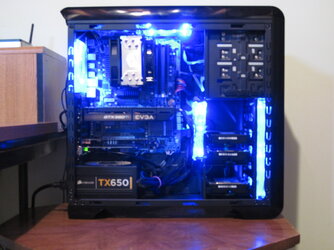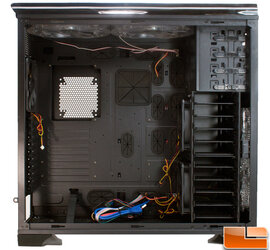i thought about this some time ago too. so I don't blame you at all.

you are thinking this right?
<-- High Static pressure fan <-- RAD <--- High CFM fan <---- air sucks in from here.
and that the RAD will reduce the CFM through resistance, so when it reaches the lower RPM fan, it will be at closer CFM of the out fan. Right? In theory, that is true. and in push/pull these fans should have the ability to build on one another.
then I thought.. what if?
<-- High CFM fan <-- RAD <--- High CFM fan <---- air sucks in from here.
would that already neglect the need of a high static pressure fan?
cause both fans in push/pull will already generate high enough static pressure together in series. and I believe I was right, though different is only around 1'C per 240 rad space, having 2 fans of high CFM is already doing all the work it needs. (15-20 FPI Rads.)
I later found, that adding a SHROUD, trumphs all of the above, especially if you are using a fan with a large blind spot. (big center) Adding a shroud between the rad and the fan not only improves air penetration, it also seems to be more positively helping the temperature too.
So don't forget a shroud if that option is feasible in the set up.



 Also, is this caused by the high CFM fan spinning faster or just the CFM difference? Perhaps, you could run the high CFM at a comparable RPM?
Also, is this caused by the high CFM fan spinning faster or just the CFM difference? Perhaps, you could run the high CFM at a comparable RPM?

 . It does come with 5 stock fans, so no complaints.I replaced the front and back fans with Antec Tri-cools, and then used the front stock fans on the top.I moved the stock 140mm on the top behind hdd's, and bought another cooler master fan for push and pull set up.Funny, those stock fans are sleeve bearing fans, and I am using both on the top of the case.Bad choice for sleeve bearing fans in a horizontal postion, but there running very quiet for 5 months now.They also push alot of air.Surprising to say the least.
. It does come with 5 stock fans, so no complaints.I replaced the front and back fans with Antec Tri-cools, and then used the front stock fans on the top.I moved the stock 140mm on the top behind hdd's, and bought another cooler master fan for push and pull set up.Funny, those stock fans are sleeve bearing fans, and I am using both on the top of the case.Bad choice for sleeve bearing fans in a horizontal postion, but there running very quiet for 5 months now.They also push alot of air.Surprising to say the least.
